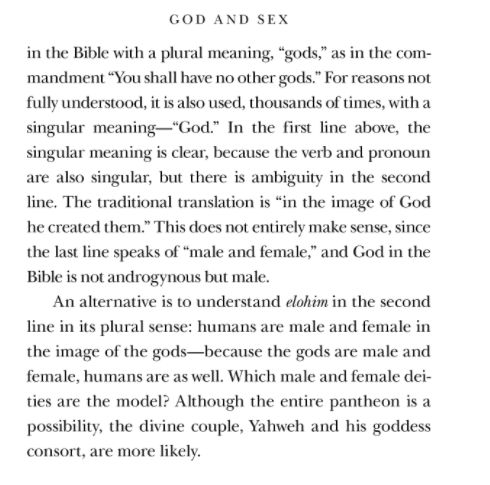MC offers the possibility that elohim should be understood as a male and female god.
- Type
- Book
- Source
- Michael Coogan Non-LDS
- Hearsay
- DirectSecondary
- Reference
Michael Coogan, God & Sex: What the Bible Really Says (New York: Twelve, 2010), 175-176
- Scribe/Publisher
- Twelve
- People
- Michael Coogan, Elohim DELETED
- Audience
- Reading Public
- Transcription
So God [elohim] created humans in his image,
in his image of elohim he created them,
male and female he created them.
The general principle here is that humans are molded on God, almost genetically— just as later in Genesis, "Adam father [a son] in his likeness, according to his image." But that abstract understanding immediately becomes concrete: humans are modeled on elohim, specifically in their sexual differences. The Hebrew word elohim is plural in form (like "cherubim" and "seraphim"), and is often used in the Bible with a plural meaning, "gods" as in the commandment "You shall have no other gods." For reasons not fully understood, it is also used, thousands of times, with a singular meaning— "God." In the first line above, the singular meaning is clear because the verb and pronoun are also singular, but there is ambiguity in the second line. The traditional translation is "in the image of God he created them." This does not entirely make sense, since the last line speaks of "male and female," and God in the Bible is not androgynous but male.
An alternative is to understand elohim in the second line in its plural sense: humans are male and female in the image of gods— because the gods are male and female, humans are as well. Which male and female deities are the model? Although the entire pantheon is a possibility, the divine couple, Yahweh and his goddess consort, are more likely.
- Citations in Mormonr Qnas
The B. H. Roberts Foundation is not owned by, operated by, or affiliated with the Church of Jesus Christ of Latter-day Saints.


